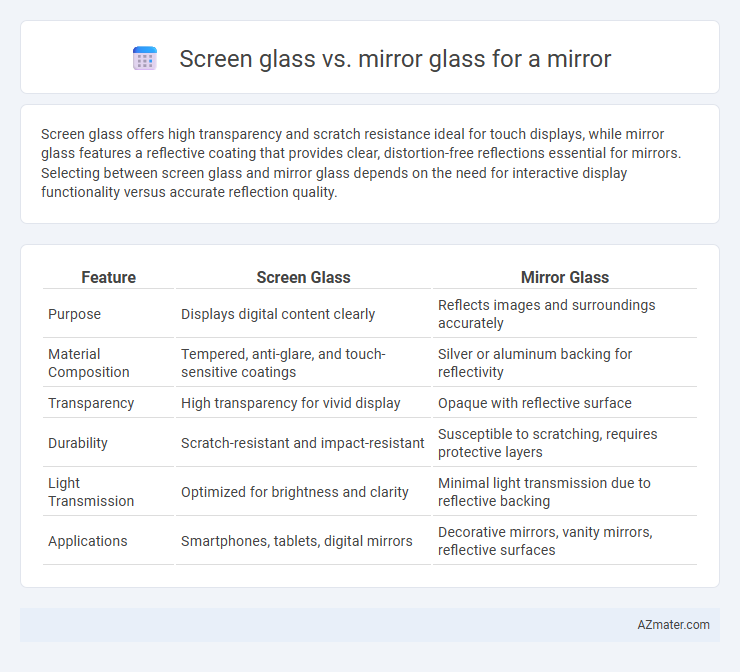Screen glass offers high transparency and scratch resistance ideal for touch displays, while mirror glass features a reflective coating that provides clear, distortion-free reflections essential for mirrors. Selecting between screen glass and mirror glass depends on the need for interactive display functionality versus accurate reflection quality.
Table of Comparison
| Feature | Screen Glass | Mirror Glass |
|---|---|---|
| Purpose | Displays digital content clearly | Reflects images and surroundings accurately |
| Material Composition | Tempered, anti-glare, and touch-sensitive coatings | Silver or aluminum backing for reflectivity |
| Transparency | High transparency for vivid display | Opaque with reflective surface |
| Durability | Scratch-resistant and impact-resistant | Susceptible to scratching, requires protective layers |
| Light Transmission | Optimized for brightness and clarity | Minimal light transmission due to reflective backing |
| Applications | Smartphones, tablets, digital mirrors | Decorative mirrors, vanity mirrors, reflective surfaces |
Introduction to Screen Glass and Mirror Glass
Screen glass features a specially coated surface designed to enhance display clarity and reduce glare, making it ideal for interactive mirrors and smart displays. Mirror glass, typically made from glass with a reflective metal backing, provides clear and crisp reflections but lacks the anti-reflective and display-enhancing properties of screen glass. Choosing between screen glass and mirror glass depends on whether the application prioritizes interactive digital displays or traditional reflective functionality.
Key Differences Between Screen Glass and Mirror Glass
Screen glass and mirror glass differ primarily in their optical properties and functionality; screen glass is designed to provide a clear display surface with anti-reflective coatings to enhance visibility, while mirror glass is coated with a reflective material to produce a true reflection. Mirror glass offers high reflectivity and is thickness-dependent for durability, whereas screen glass prioritizes touch sensitivity and scratch resistance, often incorporating Gorilla Glass technology. The key differences lie in their intended use cases: screen glass serves as a protective and interactive display barrier, while mirror glass is optimized for accurate image reflection and aesthetic purposes.
What is Screen Glass?
Screen glass is a specialized type of glass designed to integrate digital displays within a mirror surface, enabling the mirror to function as a smart display while maintaining reflective qualities. Unlike traditional mirror glass, screen glass incorporates a transparent LCD or OLED panel that allows light from the display to pass through without significantly compromising the mirror's reflective properties. This technology is commonly used in smart mirrors for applications such as fitness tracking, weather updates, and integrated home automation systems.
What is Mirror Glass?
Mirror glass is a specialized glass type coated with reflective materials, typically silver or aluminum, enabling it to produce a clear and accurate reflection. Unlike standard screen glass, mirror glass has a reflective backing that precisely bounces light back to the observer, making it ideal for use in bathroom mirrors, decorative mirrors, and optical instruments. Its reflective quality depends on the coating's thickness and application method, ensuring durability and high optical clarity.
Reflectivity: Screen Glass vs Mirror Glass
Mirror glass typically offers reflectivity rates of 80% to 90%, providing a clear and accurate reflection with minimal distortion, while screen glass usually has lower reflectivity, around 50% to 70%, to balance transparency and visibility for digital displays. High-reflectivity mirror glass is essential for applications requiring true-to-life reflections, whereas screen glass prioritizes anti-glare and light transmission properties to enhance screen readability. Selecting between screen glass and mirror glass depends heavily on whether reflection clarity or display visibility is the primary requirement.
Durability and Strength Comparison
Screen glass, often made from tempered or Gorilla Glass, offers superior durability and impact resistance compared to traditional mirror glass, which is typically composed of standard float glass. Mirror glass is more prone to scratches and shattering under stress, whereas screen glass is engineered to withstand drops and heavy usage without compromising structural integrity. For applications requiring enhanced strength and longevity, such as smart mirrors or interactive displays, screen glass provides a more robust and resilient option.
Applications: Ideal Uses for Each Glass Type
Screen glass is ideal for interactive displays and digital signage, providing clear visibility and touch responsiveness while minimizing glare and reflections. Mirror glass excels in decorative and functional applications such as bathroom mirrors, dressing mirrors, and optical instruments, offering high reflectivity and accurate image reproduction. Both glass types cater to specific needs: screen glass enhances user interaction in technology-driven environments, while mirror glass supports aesthetics and precise reflection in personal and commercial spaces.
Aesthetic and Design Considerations
Screen glass offers a sleek and modern aesthetic, enhancing mirror designs with a subtle, frameless appearance that seamlessly integrates into contemporary interiors. Mirror glass provides a classic, reflective surface that adds depth and brightness, creating a timeless visual appeal crucial for traditional and ornate design schemes. Choosing between screen glass and mirror glass depends on the desired style, with screen glass favoring minimalist looks and mirror glass supporting decorative and functional elegance.
Cost Comparison: Screen Glass vs Mirror Glass
Screen glass typically costs less than mirror glass due to its simpler manufacturing process and lower material requirements, making it a budget-friendly option for display applications. Mirror glass involves additional silvering and reflective coatings, increasing production expenses and overall price. When choosing between screen glass and mirror glass, consider the project's budget constraints and required optical properties to optimize cost efficiency.
Which Glass is Best for Your Mirror Project?
Screen glass offers superior clarity and anti-reflective properties, making it ideal for high-definition mirror projects requiring minimal distortion. Mirror glass provides a traditional reflective surface with enhanced durability and a polished finish, suitable for decorative and functional mirrors. Choosing the best glass depends on the project's needs: opt for screen glass when clarity and sharpness are paramount, while mirror glass excels in classic reflection and robustness.

Infographic: Screen glass vs Mirror glass for Mirror
 azmater.com
azmater.com